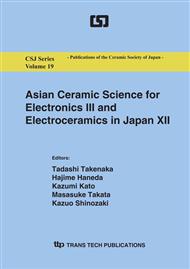p.277
p.281
p.285
p.289
p.293
p.297
p.301
p.307
p.311
The Influence of BaTiO3 Tetragonality by Solid State Synthesis on MLCC’s Dielectric Characteristics
Abstract:
BaTiO3 powders with particle size 0.1μm were made by solid state synthesis. To make high tetragonality BaTiO3 powder, mixture of TiO2 and BaCO3 was calcined in vacuum condition. And to make low tetragonality BaTiO3 powder, the mixture was calcined in air condition. With each powder, MLCCs with Ni-internal electrode were fabricated. Relationships between temperature and relative dielectric constant of MLCCs’ dielectric layers were analyzed and their dielectric grains were observed by TEM-EDS. As the result, MLCC made from high tetragonality BaTiO3 powder had good temperature characteristics and core-shell dielectric grains.
Info:
Periodical:
Pages:
293-296
Citation:
Online since:
December 2009
Authors:
Price:
Сopyright:
© 2010 Trans Tech Publications Ltd. All Rights Reserved
Share:
Citation:


